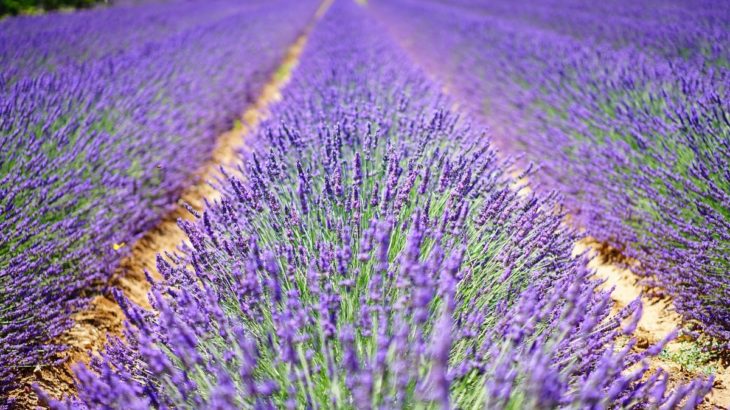Lavender Essential Oil is a potpourri of chemical ingredients, which is one reason for its versatility as a healing herb. The primary effect of lavender, both mentally and physically, is that of balancing and regulating the spirit, body and mind.
#7 of 10: Lavender Essential Oil
Lavender is a short, fragrant shrub growing to the height of 90 cm (3 feet). It is an evergreen plant with light green, lanceolate leaves and violet flowers.
Lavender belongs to the Lamiaceae (Labiatae) plant family, and its name is derived from the Latin word “lavare”, to wash. It has historically been used for washing clothes and linen, and for bathing.
Lavender is native to the mountainous areas of the Mediterranean countries. It is currently produced all over the world with the majority of the oil coming from France, Bulgaria and Russia.
Other exporters of Lavender Essential Oil are Australia (including Tasmania), England, Greece, Spain, Italy, Turkey and Croatia.
The aroma of lavender is probably familiar to most people. It has been described as bittersweet, floral and herbaceous. It gets its character from two of the chemicals making up the complex chemical structure of lavender: lavandulyl acetate and lavandulol. On the whole, lavender is a potpourri of chemical ingredients—which is one reason for its versatility as a healing herb.
The primary effect of Lavender Essential Oil, both mentally and physically, is that of balancing and regulating.
Lavender mixes happily with its relatives from the Lamiaceae family, such as marjoram and rosemary. It likes the company of fellow flower oils like geranium and the citrus oil bergamot but is not happy with oils grown further away from Europe, such as sandalwood and jasmine.
Chemical Constitution of Lavender
The main constituents of Lavender Essential Oil are:
- Ether of geranyl
- Ether of linalyl
- Geraniol
- Linalol
- Cineol
- D-borneol
- Caryophyllene
- Ester of butyric acid
- Ester of valerianic acid
- Coumarin
The exact proportion of these ingredients depends, among other things, on where the plant was grown, what kind of soil it grew in, and what the climate was like.
What Makes a High-Quality Lavender Essential Oil
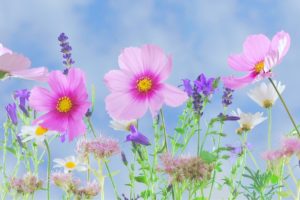
In general, dry, hot weather conditions produce oils with more health-inducing esters.
The quality of Lavender Essential Oil is also affected by the maturity of the plant. The longer it has been allowed to ripen, the better the oil will be.
An important factor in producing a high-quality Lavender Essential Oil is the altitude that the plant was grown in. The best quality oil is manufactured from lavender grown at an altitude of 600-1500 metres (1968-4921 feet).
The reason the high-altitude Lavender Essential Oil is better is that the boiling point of water at an elevation is lower, 92°C to 93°C (197.6°F-199.4°F). The lower boiling point in turn results in a higher ester content.
Lavender Essential Oil is produced by steam distillation using the flowers and stalks of the lavender plant. The absolute best, but most expensive, Lavender Essential Oil is made from the flowerheads alone, without using stalks.
Adulteration and Clones
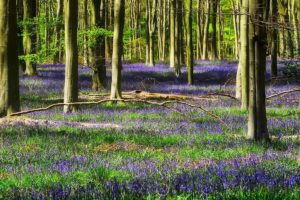
The popularity of Lavender Essential Oil has encouraged cheating. Adulteration is common. What you buy is not always pure essential oil, unfortunately.
The methods of adulteration fall into three categories:
- Addition of natural linalool and/or linalool acetate
- Addition of or substitution with lavandin oil
- Addition of synthetic linalool and/or linalyl acetate
Another complicating factor in finding and sourcing the best Lavender Essential Oil is the use of vegetative propagation, or cloning. Instead of being grown from the seeds, the cultivated clones are propagated from a cutting. This method of cultivation yields 40-50% higher crop, but an inferior end product.
The population lavender—which is grown from the seed—is more expensive to produce but yields a superior oil.
Historical Testimonials for Lavender
Lavender Essential Oil has a long history of both domestic and medicinal use. It is also one of few herbal products mentioned on the pages of the British Pharmacopoeia, until very recently.
According to Richard Surflet (1666), the “distilled water of the (lavender) flowers restoreth the lost speech, and healeth the swooning and disease of the heart.”
Pedanius Dioscorides, an ancient Greek physician (d.90 AD), prescribes lavender for “ye griefs in ye thorax.”
To Saint Hildegard of Bingen (1098-1179), on the other hand, lavender was a means to “maintain pure character.”
Lavender Essential Oil for Muscular Pain
For muscle pain, stiffness or aching, as well as rheumatoid arthritis and sciatica, use Lavender Essential Oil in massage, on its own or mix it with marjoram or rosemary essential oils.
Lavender Essential Oil eases localised pain, brings down inflammation and diminishes the nerves’ reaction to pain. It also has a general strengthening effect on musculature.
Lavender Essential Oil For Women and Children
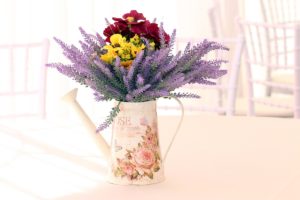
Lavender is useful for women with painful or minimal menstruation. In these cases, massage Lavender Essential Oil on the lower abdomen or use it in a hot compress.
For irritable children, or children with infection or colic, try adding 1-2 drops of Lavender Essential Oil on the child’s pyjamas or pillow.
A great help for helping a baby to sleep is to add one drop of Lavender Essential Oil into the bathwater. Mix the essential oil with a carrier oil (or a tiny bit of alcohol) to help the lavender to dissolve into the water.
Whenever using Lavender Essential Oil on children dilute the oil well. Do not let the child touch any undiluted oil and then rub it into its eyes.
Lavender Essential Oil for Flu, Cough and Other Infections
The antibiotic, antiseptic and analgesic qualities of Lavender Essential Oil make it an effective remedy for flu, coughs, catarrh and sinusitis.
For flu, use steam inhalation from very hot water. Besides being a pleasant experience, the combination of hot water and Lavender Essential Oil attacks the flu itself.
If you have a cough, massage Lavender Essential Oil neat onto your throat to relieve itching.
With catarrh, rub Lavender Essential Oil on the acupressure points on the eyebrow ridges and the sides of your nostrils.
Lavender Essential Oil for Burns
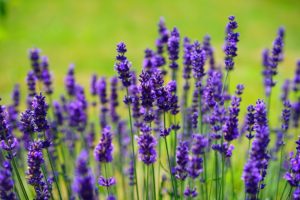
Lavender Essential Oil is famous as a treatment for burns. It speeds up the healing process and minimises scarring.
René-Maurice Gattefossé (1881-1950), called the “father of aromatherapy”, started research into the burn-healing properties of lavender after burning his hand in a laboratory experiment and managing to heal it with Lavender Essential Oil.
Another Frenchman, army surgeon and aromatherapist, Jean Valnet used Lavender Essential Oil to treat soldiers with burns or battle wounds.
Calm Your Heart with Lavender
For the heart, Lavender Essential Oil has a sedative effect. It helps to reduce high blood pressure and can be used when the patient has heart palpitation. Use in massage or prepare a lavender bath (with water that is not too hot).
Lavender Essential Oil for Problem Skin
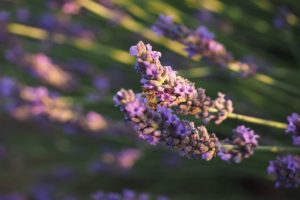
Lavender Essential Oil helps with various skin problems. Its effects are soothing, antibacterial and anti-inflammatory. It can be used to treat, for example, acne and eczema.
For skin treatments, make a mixture of 1-2% Lavender Essential Oil blended with skin tonics, creams or lotions.
Lavender can also be used to combat fungi such as ringworm or athlete’s foot.
Lavender Essential Oil as an Insect Repellent
As an insect repellent, Lavender Essential Oil is used to treat clothes and linen and thus protect them from moths. It can also be used in sprays to repel fleas from dogs.
To repel mosquitos, spread Lavender Essential Oil on your skin neat or mixed with grapefruit or eucalyptus essential oils.
Applied neat on the skin after an insect bite, Lavender Essential Oil is apt to alleviate the pain and stop the itching.
Lavender Essential Oil for the Mind

On a psychological level, Lavender Essential Oil has been used to treat mental imbalances for hundreds of years.
According to John Gerard (1597), lavender “doth help the passion and panting of the heart.”
In Chinese Traditional Medicine, Lavender Essential Oil is believed to calm down and assist the flow of the Qi of heart. It releases repressed energy accumulated by long-time frustrations and stress.
Lavender Essential Oil is also used for mood swings, manic depression and hysteria. It pacifies extreme emotions and helps to restore a composed state of mind.
For depression, anxiety and other mental disorders, massage Lavender Essential Oil on both sides of the spine or hop into a lavender bath before bedtime.
Finally, Lavender Essential Oil is recommended for talented performers with stage fright. It will help them to open up artistically and to better express themselves, whether onstage or off.
Safety
Allergies to Lavender Essential Oil are rare. If you dislike the smell of lavender you may be someone that has a sensitivity to lavender. In this case, do not use it. For everyone else, Lavender Essential Oil is safe to use.
Shop for Lavender Essential Oil in store today >>
